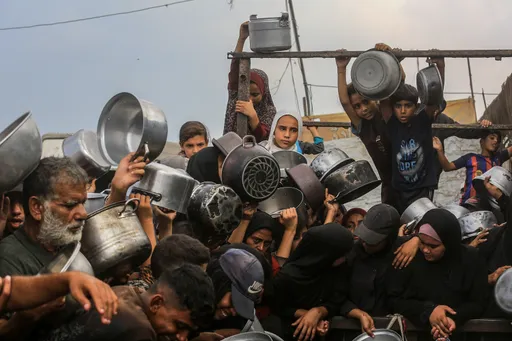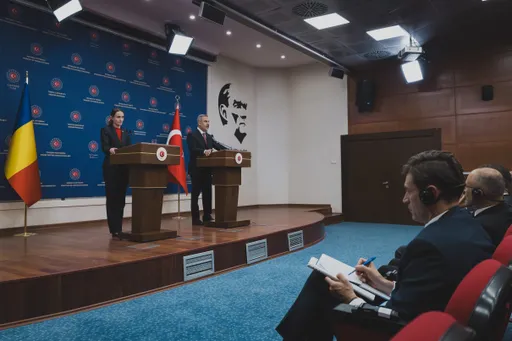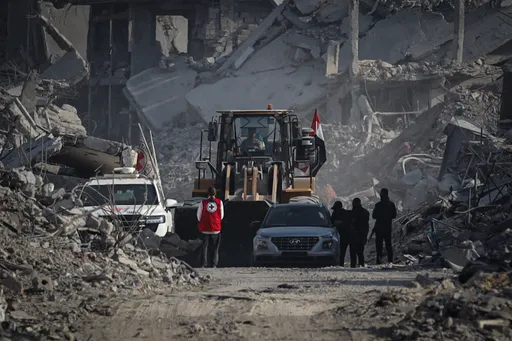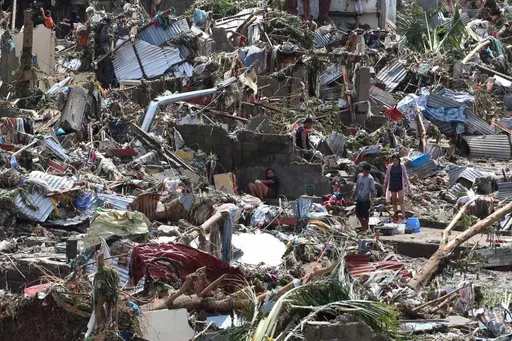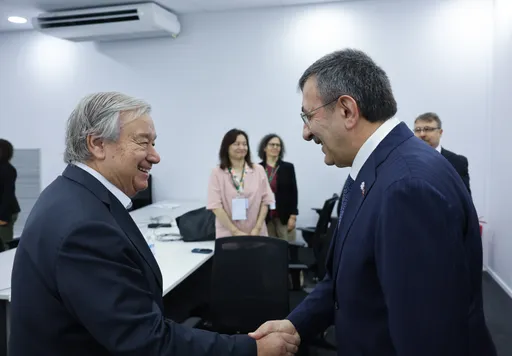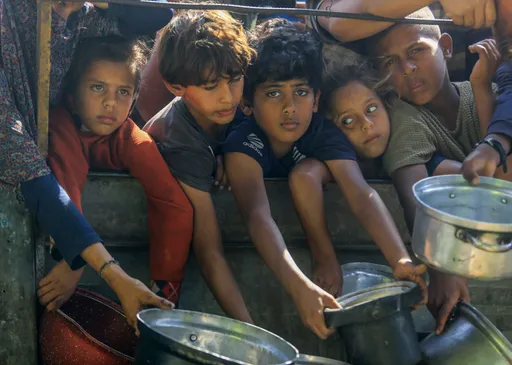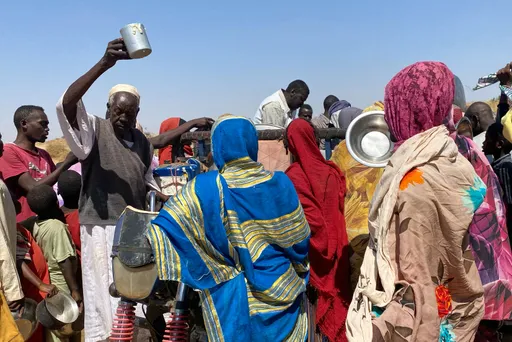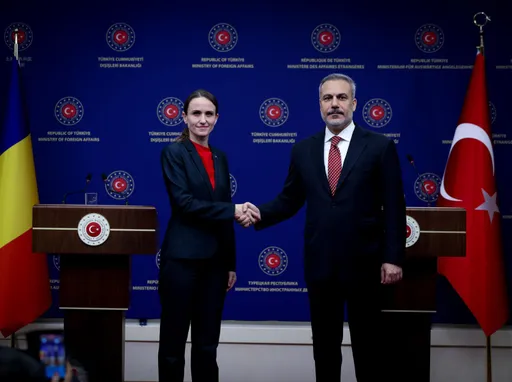On a recent afternoon, a few daily wage labourers were digging and shovelling at the site of an under-construction road in Nayakpura village in the Indian state of Uttar Pradesh (UP).
The sun was beating down with such fury that it felt it was hiding somewhere under the ground rather than blazing overhead in a clear blue sky. The temperature exceeded 45 degrees Celsius.
The entire area was like a very hot furnace in which exhausted labourers dragged their feet to move around. Every now and then, one of the workers would take a break to sit under the share of a nearby tree and catch his breath. Shared water bottles exchanged hands. Each break lasted only ten minutes. The work never stopped.
Shubh Prakash, a 32-year-old migrant worker, travelled 70 kilometres from UP's Deoria district to work with a small company in Nayakpura. He can now rely on a stable income for a few months until the project ends. His friend, who also works in construction referred him for the job.
"We often feel suffocated, our blood pressure goes up and down and there’s a constant dizziness," Prakash tells TRT World.
A very hot reality
Climate change is intensifying the frequency and severity of heatwaves in India, as the South Asian country experiences one of its severest heatwaves. Temperatures consistently touch 50 degrees Celcius in different cities.
The World Meteorological Organisation says: “A heatwave is a period where local excess heat accumulates over a sequence of unusually hot days and nights.”
NIH, a medical journal, reports that heatwaves caused over 153,000 additional deaths annually from 1990 to 2019 globally, with Asia being the most affected continent. The report says the figure could be much higher since many deaths remain unreported.
At times, it was so unbearably hot that schools began early closures as videos and pictures of students fainting in classrooms and rickshaws went viral.
A water shortage in parts of New Delhi and neighbouring states has added to the misery of the people. In some neighbourhoods, residents run after water tankers with buckets and containers in their hands. The authorities have struggled to deal with the surging water demand.
Outdoor tyranny
People who work in offices, especially those employed in companies that can afford air conditioners, don’t feel as much pain as those who earn a living toiling on the roads and in the fields.
Ravikant Mishra, 40, is an attendant at a petrol pump in Badarpur, Delhi. He endures intense heat and dry winds all day long.
“I work in these conditions for 8-10 hours a day,” he says. “Sometimes I dip a piece of cloth in water and put it on my head to cool down. My job requires me to stand outside and heat has made this work very difficult.”
Similarly, Hemchand Yadav, 50, a street vendor who sells fruits from a pushcart in south-east Delhi, must brave the scorching temperatures daily to make a living. "I roam around several streets selling my fruits in this weather," he says
"The heat is unbearable, and there’s no shade on most of the streets. I carry a bottle of water, but it’s never enough. Sometimes, I feel dizzy and have to sit down to catch my breath.”
Yadav starts his day early, loading his cart with a variety of fresh fruits. By noon, the temperatures soar, making his job increasingly challenging.
He continuously worries about the effect of the high temperature on his fruits.
Bananas turn brown quickly when exposed to the sun. To prevent bananas from ripening fast, he uses wet jute bags to cover them.
"I can't afford to take a day off. My livelihood depends on daily sales. In my trade, a heatwave makes it harder to find customers, as people prefer to stay indoors. It's a struggle, but I have no choice.”
The fallouts of climate change including the heatwaves and record temperatures are hitting the poorest people disproportionately hard, says
Joyeeta Gupta, Professor of Environment and Development in the Global South, University of Amsterdam.
“If you're a farmer, you're out in the field then you will be affected. If you're a miner, you'll be affected as well. Essentially, people who work on the streets, such as local vendors, street police, and beggars, are all significantly impacted.
“Those in small shops that don't close their doors to the public will also be much more exposed to increasing heat. They will also face reduced water availability during shortages caused by climate change.”
When the temperatures rise to a concerning level, authorities urge residents to stay indoors and take necessary precautions to protect themselves from the severe heat.
In India, like many other developing and poor countries, daily wage work is considered part of the informal economy. The labourers don’t have access to health insurance or protection for work-related injuries. Once the day’s work ends, there’s no knowing what happens the next day.
New Delhi’s own data shows that there are more than 276 million workers in the informal sector.
“Essentially if you are a day laborer paid on a daily basis, you don't get paid if you don't show up to work. This is a universal issue: daily wage labourers suffer the most because they don't earn anything for the days they can't work. Even when they have relatively decent contracts, these contracts should consider weather conditions. If it's too cold, raining heavily, or too hot, labour laws should require that these workers are paid for externalities,” says Gupta.
A long-term impact
Environmental experts have raised concerns about the long-term implications of recurring heat waves for the environment and human life.
Extreme temperatures are expected to accelerate water evaporation, leading to a significant water crisis in different parts of the world.
“Warm weather results in fast evaporation of water from the water bodies. It leads to severe water shortage issues including drought, a slow killer. It affects food production and many sectors, even industries may not be able to function well,” says Gupta.
The Intergovernmental Panel on Climate Change (IPCC) says heat waves that previously occurred once every decade are now happening nearly three times as often and are 1.5 degrees Celcius hotter. These trends are expected to worsen if global CO2 emissions are not reduced rapidly.
Rising greenhouse gas emissions will increase global temperature and extreme weather aberrations. In India, it will cause water shortages and glacier melting, says Gupta.
It's not only humans who are suffering but also animals. A few days back, a video of a policeman giving CPR to a monkey in Uttar Pradesh's Bulandshahr city went viral. The monkey had collapsed due to the intense heat.
Animals and birds, which live in the cities and lack natural shelter, are worst affected.
The Delhi Zoo has installed coolers and sprinklers to ease animals' suffering. Wildlife SOS, a conservation NGO, has ramped up rescue operations and made dietary adjustments to ensure animals stay hydrated during the heatwave. A charity bird hospital is offering free treatment to birds suffering from heatstroke in Delhi.
Political parties look the other way
Despite the visible impact of heatwaves, climate change did not emerge as a prominent issue in India's recent elections.
“Climate change has no political colour and will affect all. Rich will have a slight advantage over the poor due to their financial cushion, enabling them to cope better. However, this cushion won't provide lasting support," warns Gupta.
The absence of climate change from political discourse raises concern about the lack of priority that’s given to environmental issues.
Gupta says that politically, there is growing fear worldwide, particularly in Western countries, that climate goals of limiting global warming to 1.5 or even 2 degrees Celsius may not be met.
Developing countries, often under-informed, face immediate risks but may resist climate action due to economic costs.
‘Like a COVID-19 emergency’
Gupta emphasises treating climate change as an emergency similar to COVID-19.
The global emissions gap between rich and poor countries is widening, with wealthier nations historically emitting far more greenhouse gases.
However, in all countries, the rich are often the biggest polluters, benefiting from better living conditions and resources.
This disparity leaves poorer communities more vulnerable to climate impacts like extreme weather and water scarcity. The failure to transition away from fossil fuels over the past 35 years has worsened inequality, as poorer areas struggle to adopt cleaner technologies.
The rich can afford electric cars, solar panels, and heat pumps, and subsidies are available to early adopters. However, poorer individuals face difficulties accessing these subsidies due to a lack of funding and planning support.
Labour laws often fail to protect workers from heat-related health risks, contributing to a rise in heat-related deaths. Both rich and poor countries resist phasing out fossil fuels due to economic concerns, despite the growing climate emergency.
Climate change, with melting glaciers and extreme weather patterns, particularly affects India.
Groundwater depletion worsens the situation with excessive extraction for irrigation and industrial use. Urgent action is needed, with a focus on mitigation efforts. However, resistance to change remains.
And nothing is changing for the poorest segment of the society.
Shanti, a 33-year-old migrant worker from Jhansi, Uttar Pradesh, works as a daily wage construction labourer in Delhi. She lives with her husband to make ends meet, knowing she has no choice but to work even if it's unbearably hot.
"I don't have any option other than going out and working in every weather. Otherwise, my family will sleep on empty stomachs. I have no savings and I earn every day and spend every day," she says.
"I have no time to fall sick, and so I keep working here.”







